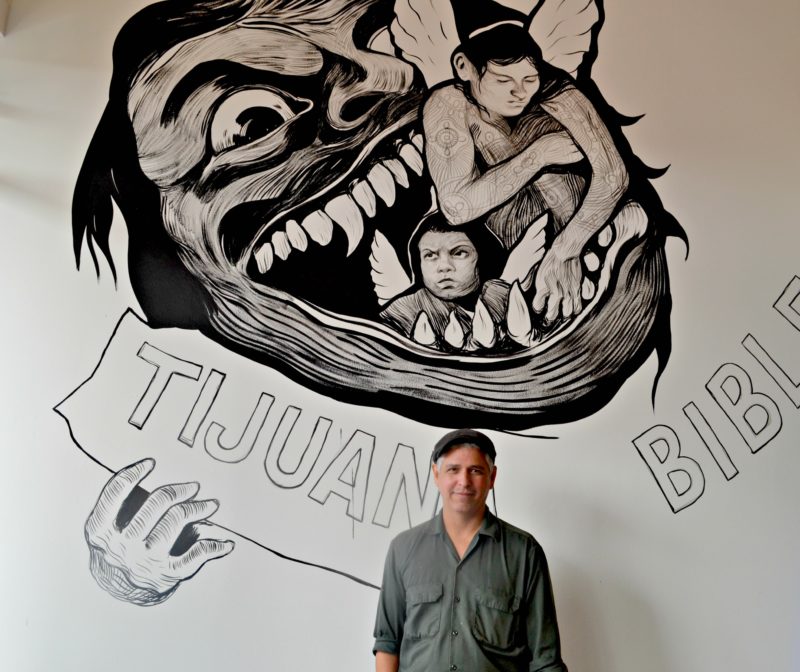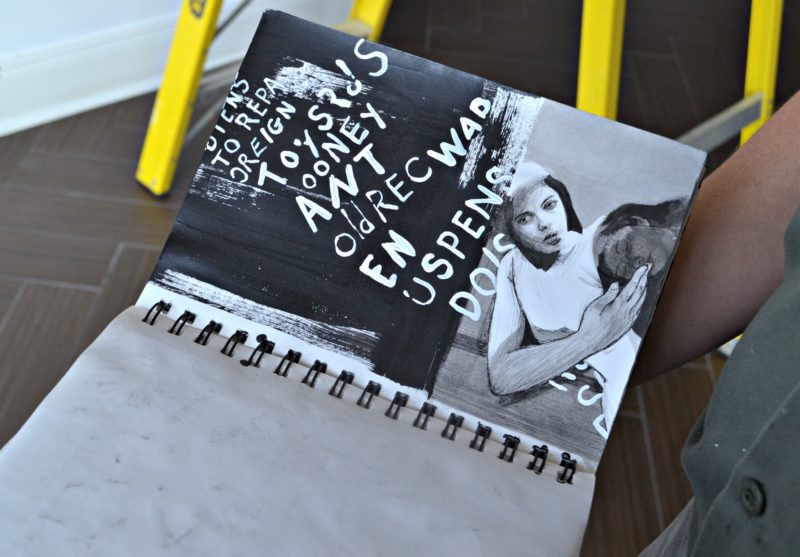
Hugo Crosthwaite mid-mural at the Consulate of Mexico (photos by: Kelley Crawford)
Who: Hugo Crosthwaite
What: Visual artists
Where: Originally from Tijuana and staying in our fine city of New Orleans for his opening of Sin Titulo, a new exhibition at Jonathan Ferrara Gallery produced in collaboration with the Consulate of Mexico in New Orleans featuring seven Mexican contemporary artists
Q: Who introduced you to something you love?
HC: My brother introduced me to drawing when I was very young. I grew up in a touristy town in Tijuana. My father owned a curio shop, and we worked at the store every day after school. I hated working at that store [laughing]. To pass the time, my brother and I would put out a big sheet of paper and start drawing.
This was back in 1977 when Star Wars had come out, and my brother came up with a game where he would be The Empire and I would be The Rebellion. He would draw a cruiser on one side of the paper, and on the other end I would draw a Millennium Falcon. I would draw laser-fire towards one of his ships, and then draw the explosion. He would do the same thing back at me, and we would spend hours drawing back and forth. At the end of the day, we had this entire narrative of a space battle on this sheet of paper.
He doesn’t draw anymore. I was the only one who turned this game into my life [laughing], but my brother was the one who introduced me to my passion.
Q: If you were to wake up tomorrow as a woman, how do you think your life would change?
HC: My life would be a lot harder, especially coming from Mexico. There is a lot of misogyny in Mexico, and it is so difficult, especially as an artist, for a woman to be taken seriously. Even as a Mexican male artist, in Tijuana art is still seen as something you do on the weekend. It is a hobby. It is not considered a profession or vocation. As a woman, it would be even harder to be taken seriously in that world of art.
I feel like you have to respond to that kind of resistance the best way you can–through your work. I have always said that you can’t really talk your way into anything; the art has to take you there. If the work is good, people will recognize it. I have never been able to convince anyone that my work is good through explaining it or talking about it [laughing]. They have to see it.
Q: What do you feel like people can recognize in your work from piece-to-piece?
HC: My work is primarily in black and white. The reason for that is, I am self-taught, so the materials I learned from were black ink or pencil. I have always been attracted to the aesthetic of black and white imagery. Especially for creating a narrative. Color can be a distraction.
When I was growing up in Tijuana in the 70s and 80s, the concept of art as a serious profession didn’t exist. When I was in high school, though, we had to choose a track of what we wanted to study. Of course, when I said I liked to draw, I got the options of becoming an architect or a graphic designer. Architecture had math [laughing], so I studied graphic design. I ended up studying at San Diego State University, but in the end I hated the career of graphic design. Everything was done on the computer. It wasn’t drawing.
The thing was, my dad’s dream was that his sons would each have a college degree. I was miserable studying graphic design, but I knew I couldn’t quit school, so I went to my counselor and said, ‘I have all of these classes. What can I do to graduate right now?’ He pointed me in the direction of art history, and I was able to graduate with a bachelors in Applied Arts and Sciences. Mind you, I don’t know what that means, but it was a degree [laughing].
Those classes in art history changed my life. I learned for the first time about art and the lives of artists, and I realized: This is what I want to do! I went back home, showed my dad my diploma, and then said, ‘I am becoming an artist.’

Drawings by Hugo Crosthwaite (photos by: Kelley Crawford)
Q: Where do you feel like myth and stories play a part in your life?
HC: I think myths and stories are essential in my work. All of my work is narrative-base. I improvise the narrative on the spot when I am creating. I don’t see a scene or a photograph and draw that; in fact, I don’t have any sketches. When I start a drawing, it gets finished.
When I talk to other painters about their creative process, they talk about how they do a lot of preparatory sketches, then they get the canvas, they transfer the drawing to the canvas, and then they paint. That is a large investment and a lot of time, and is completely different from the way I work.
Then I talked to poets. They would tell me how they sit down, then write a word, and then they write another word and so on, stringing together ideas and images. This level of improvisation is more immediate than painting. My drawing has this level of immediacy. You tell a story detail to detail.
You can’t stop a story in the middle, so my stories always get finished in my drawings.
Q: What do you feel like you can definitely know?
HC: I definitely know that I can draw. That’s a sure thing. I feel like that happens with any art or discipline. If you are a musician and you play the violin, through years of practice you master your instrument, so then you know how to improvise.
When I work on a mural people will say, ‘You did this in a day?’ and I think, ‘Yes, I did this in a day with twenty years of practice’ [laughing]. It’s a cumulative process. You learn how to loosen the hand and the arm, and all of my work is within the scale of my human body.
None of my work is transferred or projected. It’s all drawn through the level of my hand–wherever my arm can reach is as far as my mural will go. You will see my work at the human scale because my art is me.
This is why whenever I do my mural work, I wear this shirt.
[Turns around and shows the back of his shirt that says ‘Hugo Rotulos’]
Rotulos means ‘sign painter’ in Spanish, and one day in Tijuana, I saw this old rotulista, this old sign painter, and he came in with a brush and drew a perfect ‘a’ on the wall. I sat there for hours watching this man draw these perfect letters across the wall and all within the confines of his body.
I thought that level of craftsmanship is amazing. No projection, no sketching, just his skill from years of practice. That is what I aspire to.
Hugo Crosthwaite is currently on display at the Consulate of Mexico (901 Convention Center Blvd), and the opening will be at 5:00 PM on Saturday, November 4. His opening of Sin Titulo, a new exhibition at Jonathan Ferrara Gallery produced in collaboration with the Consulate of Mexico in New Orleans featuring seven Mexican contemporary artists, will also be opening this Saturday, November 4 at 7:00 PM. His work at Jonathan Ferrara Gallery will remain up through December 30. To learn more about Hugo Crosthwaite and his work, you can visit his website as well as follow him on Facebook and Instagram.
 NOLAbeings Multimedia artist Claire Bangser created NOLAbeings as a portrait-based story project that marries...
NOLAbeings Multimedia artist Claire Bangser created NOLAbeings as a portrait-based story project that marries...  Voodoo in New Orleans: Reviving history: New Orleans fortune telling This article takes a deep dive into the history of Voodoo in New Orleans, its hybridization with Catholicism, and its present-day place in the city's culture. The author visits fortune-tellers in the French Quarter, using their guidance as a tool for introspection rather than a deterministic predictor of the future. Through her experiences in New Orleans, the author feels a mystical connection to both the past and the future.
Voodoo in New Orleans: Reviving history: New Orleans fortune telling This article takes a deep dive into the history of Voodoo in New Orleans, its hybridization with Catholicism, and its present-day place in the city's culture. The author visits fortune-tellers in the French Quarter, using their guidance as a tool for introspection rather than a deterministic predictor of the future. Through her experiences in New Orleans, the author feels a mystical connection to both the past and the future. 